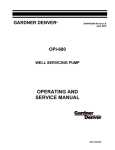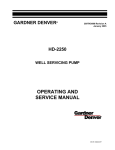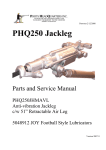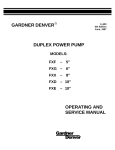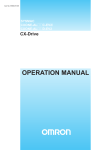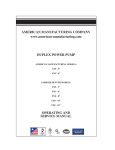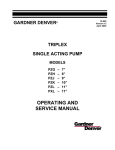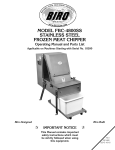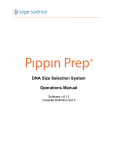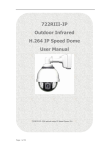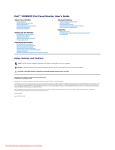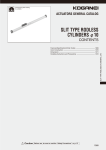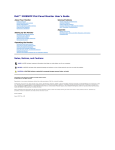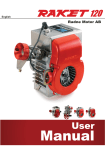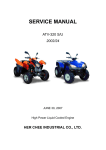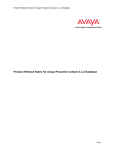Download OPERATING AND SERVICE MANUAL
Transcript
GARDNER DENVER®
300FWB996 Rev B
January, 2005
WELL SERVICING PUMP
MODEL
COMPACT
OPERATING AND
SERVICE MANUAL
ECN 1024021
COMPACT
WELL SERVICING PUMP
MAINTAIN PUMP RELIABILITY AND PERFORMANCE WITH
GENUINE GARDNER DENVER
PARTS AND SUPPORT SERVICES
Gardner Denver® genuine pump parts are manufactured to design tolerances and are developed for
optimum dependability. Design and material innovations are the result of years of experience with
hundreds of different pump applications. Reliability in materials and quality assurance is incorporated
in our genuine replacement parts.
Your authorized Gardner Denver Sales Office offers all the backup you ll need. The Fort Worth
Manufacturing Facility maintains a large inventory of genuine parts.
Gardner Denver supports your needs with these services:
1.
Trained parts specialists to assist you in selecting the correct replacement parts.
2.
Repair and maintenance kits designed with the necessary parts to simplify servicing your pump.
Authorized service technicians are factory trained and skilled in pump maintenance and repair. They
are ready to respond and assist you by providing fast, expert maintenance and repair services.
For the location of your local authorized Gardner Denver distributor, refer to the yellow
pages of your phone directory or contact:
Factory (Tulsa):
Gardner Denver Well Servicing Pumps
4747 South 83rd East Avenue
Tulsa, Oklahoma 74145
Service Center (Odessa):
Chaparral
2121 West 44th Street
Odessa, Tx 79768
Factory (Ft. Worth):
Geoquip
7533 Kathy Lane
Ft. Worth, Texas 76126
Phone:
(918) 664-1151
(800) 738-8099
Phone:
(432) 366-5433
(800) 368-1134
Phone:
(817) 249-6400
(800) 824-0271
Fax:
(918) 664-6225
Fax:
(432) 363-9940
Fax:
(817) 249-6401
INSTRUCTIONS FOR ORDERING REPAIR PARTS
When ordering parts, specify Pump MODEL and SERIAL NUMBER (see nameplate on unit).
The Serial Number is also stamped on top of the cylinder end of the frame (cradle area).
All orders for Parts should be placed with the Tulsa or Ft. Worth facility.
Where NOT specified, quantity of parts required per pump or unit is one (1); where more than
one is required per unit, quantity is indicated in parenthesis. SPECIFY EXACTLY THE NUMBER
OF PARTS REQUIRED.
Page i
FOREWORD
Gardner Denver® pumps are the result of advanced engineering and skilled manufacturing. To
be assured of receiving maximum service from this pump the owner must exercise care in its
operation and maintenance. This book is written to give the operator and maintenance personnel
essential information for day-to-day operation, maintenance and adjustment. Careful adherence
to these instructions will result in economical operation and minimal downtime.
DANGER
Danger is used to indicate the presence of a hazard, which will cause severe
personal injury, death or substantial property damage if the warning is ignored.
WARNING
Warning is used to indicate the presence of a hazard, which can cause severe
personal injury, death or substantial property damage if the warning is ignored.
CAUTION
Caution is used to indicate the presence of a hazard, which will or can
minor personal injury or property damage if the warning is ignored.
NOTICE
Notice is used to notify people of installation, operation or maintenance
information which is important but not hazard related.
Page ii
cause
TABLE OF CONTENTS
Maintain Pump Reliability and Performance with Genuine Gardner Denver Parts and
Support Services................................................................................................................ i
Instructions For Ordering Repair Parts...................................................................................... i
Foreword .................................................................................................................................... ii
Index .......................................................................................................................................... iv
List of Illustrations ...................................................................................................................... v
Section 1, Danger Notices ......................................................................................................... 1
Section 2, Design, Description and Specifications .................................................................... 9
Section 3, Preparation, Operation and Maintenance................................................................. 15
Section 4, Service Procedures .................................................................................................. 21
Section 5, Trouble-Shooting ...................................................................................................... 27
Section 6, Rebuilding Data, Recommended Running Clearances ........................................... 33
Section 6, Torques
...34
Warranty................................................................................................................................ Last Page
Page iii
INDEX
Crankshaft Assembly ....................................26
Performance Rating......................................... 14
Crosshead Assembly
...............................24
Periodic Routine Maintenance Schedule ........ 18
.....................................25
Plunger / Packing Lubrication.......................... 17
Daily Routine Maintenance Schedule...........19
Plunger Packing Lubrication Recommendation
Chart.......................................................... 20
Crosshead Guides
DANGER NOTICES, SECTION 1 ..................1
Plungers and Packing Replacement ............... 22
Covers and Guards.................................2
Power End .................................................. 10,24
Equipment Moving and Lifting ................2
Power End and Gear Reduction
Unit Lube System...................................... 12
Flammable, Hot, Cold or Corrosive
Fluid Pumping.................................5
Power End Lubrication System ....................... 16
Hammer Lug Fasteners
.. ..1
Preparation after Shipping and Storage .......... 15
High Pressure Liquid Jetting,
Blasting and Cleaning.....................6
PREPARATION, OPERATION AND
MAINTENANCE, SECTION 3................... 15
Pressurized Pump Systems....................3
Pump Design ................................................... 10
Valve Seat Pulling...................................2
Pump Mounting Instructions ............................ 15
DESIGN DESCRIPTION AND
SPECIFICATIONS, SECTION 2.............9
Quarterly Routine Maintenance Schedule....... 19
Fluid End Description....................................13
Rebuilding Data ............................................... 33
Fluid End Removal and Installation ..............21
Fluid End Service..........................................21
REBUILDING DATA, RECOMMENDED
RUNNING CLEARANCES AND
TORQUES, SECTION 6 ........................... 33
Foreword
Recommended Running Clearances
.. . .. ii
Actual 33
Gear Reduction Unit ................................11,26
Repair Parts, Ordering Instructions .....................i
General Requirements and Safety Rules .....21
SERVICE PROCEDURES, SECTION 4 ......... 21
General Specifications ..................................14
Specifications, General.................................... 14
Introduction .....................................................9
Startup and New Pump Run-In Procedure...... 17
Lube Pump Suction Piping Sizing and
Requirements........................................16
Torques............................................................ 34
TROUBLE-SHOOTING, SECTION 5 .............. 27
Lube System Pump.......................................16
Lubrication, Plunger / Packing ......................17
Warranty ................................................... Last
Page
Monthly Routine Maintenance Schedule ......19
Valve and Seat Replacement .......................... 22
Oil Stop Head Seal Retainer and Crosshead
Pin Orientation for Proper loading ........24
Ordering Instructions, Repair Parts ................. i
Page iv
LIST OF ILLUSTRATIONS
Figure #
Description
Page
Figure 2-1
COMPACT Triplex Pump ........................................................................... 9
Figure 2-2
COMPACT Power End .............................................................................. 10
Figure 2-3
COMPACT Power End Top View............................................................. 11
Figure 2-4
COMPACT Gear Reduction Unit............................................................... 12
Figure 2-5
COMPACT Fluid End ................................................................................ 13
Figure 3-1
Lubricant Recommendations..................................................................... 17
Figure 4-1
Fluid End Assembly................................................................................... 22
Figure 4-2
Packing Assembly ..................................................................................... 22
Figure 4-3
Crosshead Assembly ................................................................................ 25
Page v
SECTION 1
DANGER NOTICES
DANGER
Read and understand the following
DANGER NOTICES before moving or
operating the pump or any pump package
unit equipment.
Reciprocating pumps are machines capable
of producing high fluid pressures and flow
rates and are designed to be used with
proper care and caution by trained,
experienced
operators.
TO
AVOID
PERSONAL INJURY, DEATH AND/OR
EQUIPMENT DAMAGE, READ AND
THOROUGHLY
UNDERSTAND
THE
FOLLOWING DANGER NOTICES PLUS
THE ENTIRE OPERATING AND SERVICE
MANUAL BEFORE ATTEMPTING TO
MOVE OR OPERATE THE PUMP. Contact
a Gardner Denver service representative if
you are unable to comply with any of the
danger notices or procedures described in
these documents.
Closely examine the pump performance
data upon pump delivery to become
thoroughly familiar with the operating limits
for this pump model. The pump must
never be operated at speeds, pressures
or horsepower exceeding the maximum
values or at speeds below the minimum.
Failure to observe the operating limits
could result in personal injury, death,
and/or equipment damage and will void
the warranty. Alterations to the pump, or
application of the pump outside the limits,
must not be made without Gardner Denver
written approval, together with a new set of
performance data, as dangerous operating
conditions could result.
The timely replacement of expendable parts
and any other worn or damaged parts can
prevent equipment damage and possible
injury. The original parts used in Gardner
Denver pumps are designed and tested to
exacting standards to provide high quality
performance and durability.
Your best
insurance
in
maintaining
these
characteristics is to use genuine Gardner
Denver replacement parts.
A broad range of danger notices are
covered on these pages, however, they
cannot substitute for training, experience
and common sense in the safe operation of
high pressure pumping equipment.
HAMMER LUG FASTENERS
DANGER
On pumps equipped with hammer lug
unions and/or hammer lug valve covers the
following precautions must be observed to
avoid personal injury, death and/or
equipment damage due to contact with the
hammer, broken parts from the hammer,
lugs or other objects propelled by hammer
blows.
When tightening or loosening
hammer lug unions and valve covers,
operators or maintenance personnel should:
Inspect the hammer and hammer lugs
to insure they are all in good condition.
Replace any of these parts which are
cracked, damaged or badly worn.
Wear safety shoes and safety glasses.
Alert other personnel to move away
from the area.
Keep in mind that full operator attention and
alertness are required when operating high
pressure pumping equipment. Operators
should not begin or continue operations
when tired, distracted or under the influence
of alcohol or any type of prescription or
nonprescription drugs.
Check to insure they have safe footing.
Fully engage the hammer bar, if one is
used, to prevent it from disengaging
violently from the cover as a blow is
struck.
Page 1
Wipe their hands and the hammer
handle and maintain a firm grip on the
handle to avoid losing control of the
hammer while swinging and striking.
Check to insure they have safe footing.
Fully engage the wedge to prevent it
from disengaging violently from the
cover as a blow is struck.
Carefully swing the hammer to avoid
striking themselves, another person and
objects other than the targeted lugs or
hammer bar.
Wipe their hands and the hammer
handle and maintain a firm grip on the
handle to avoid losing control of the
hammer while swinging and striking.
Avoid swinging the hammer above
shoulder height.
Carefully swing the hammer to avoid
striking themselves, another person and
objects other than the targeted wedge.
VALVE SEAT PULLING
Avoid swinging the hammer above
shoulder height.
DANGER
COVERS AND GUARDS
The following precautions must be observed
by operators and maintenance personnel to
avoid personal injury, death and/or
equipment damage from contact with the
puller, hammer, wedge or broken parts from
these components when using either a
hydraulic or wedge valve seat puller.
Operators or maintenance personnel
should:
DANGER
Personal injury, death and /or
equipment damage can result from
contact with moving parts. All
moving parts must be equipped with
covers and guards. All covers and
guards must be securely positioned
at all times when the unit is in
operation.
Hydraulic Seat Puller
Wear safety shoes and glasses.
Chain or tie the jack down as it will jump
violently
when
the
valve
seat
disengages from the valve deck.
Covers and guards are intended to not only
protect against personal injury or death, but
to also protect the equipment from foreign
object damage
Check to insure the pressure applied by
the hydraulic pump does not exceed the
hydraulic ram maximum pressure rating.
EQUIPMENT MOVING AND LIFTING
Wedge Seat Puller
Grind off any mushroomed material from
the wedge before use.
DANGER
Heavy equipment including pumps, pump
packages and components should only be
moved or lifted by trained, experienced
operators, who are physically and mentally
prepared to devote full attention and
alertness to the moving and lifting
operations. An operator should be fully
aware of the use, capability, and condition of
Inspect the hammer and wedge to
insure they are in good condition.
Replace any of those parts which are
cracked, damaged or badly worn.
Wear safety shoes and goggles.
Page 2
both the equipment being moved and the
equipment being used to move it.
as fully assembled should be separated into
smaller loads.
For these smaller loads the lifting devices
should be fastened to the lifting attachments
normally built into the individual motor,
engine, pump or transmission / torque
converter, or their separate support skids.
DANGER
Failure to follow safe and proper
pump, pump package or component
lifting or moving procedures can lead
to personal injury, death and /or
equipment damage from shifting,
falling or other unexpected or
uncontrolled equipment movements.
When lifting subassembled components, for
example a suction stabilizer attached to
suction piping or a discharge pulsation
damper attached to a strainer cross and
piping, use special lifting slings designed to
safely support the combined weight of the
components.
If a crane or hoist is being used to lift large
components or assemblies, one or more
persons should assist the operator from the
ground with guide lines attached to the
equipment being moved to properly position
it and prevent uncontrolled movement.
Make sure the hoist, lift truck, ropes, slings,
spreader bar or other lifting equipment you
are using is in good condition and has a
rated lifting capacity equal to or greater than
the weight being lifted. Lifting devices must
be checked frequently for condition and
continued conformance to rated load
capacity. They should then be tagged with
the rated capacity together with the date of
inspection.
When you start to lift a pump, package unit,
subassemblies or individual components
and you observe the equipment is tilting, or
appears unbalanced, lower the equipment
and adjust the lifting device to eliminate
these improper lifting conditions before
proceeding to move the equipment.
Fully assembled pumps and pump
packages are heavy and should only be
moved using the specified lifting lugs or
attachments.
It is poor practice and dangerous to allow
the equipment to pass over or close to your
body or limbs. Be prepared to move quickly
out of danger if equipment starts to fall, slip
or move unexpectedly toward you.
Many individual components have lifting
eyes or lugs which must not be used to
lift assemblies, as they are designed to
bear the weight of the component only.
Before lifting the individual component
check to insure the lifting attachment is
firmly secured to the component with
undamaged, properly torqued fasteners,
sound welds, or other secure attachments.
Examine the lifting eyes, lugs, slots, holes or
other projections to insure they are not
cracked, otherwise damaged or badly worn.
The repair of existing or addition of new
welded lifting eyes, lugs or other projections
should only be performed by experienced,
qualified welders.
PRESSURIZED PUMP SYSTEMS
DANGER
Fluids under high pressure can
possess sufficient energy to cause
personal
injury,
death
and/or
equipment damage either through
direct contact with escaping fluid
streams or by contact with loose
objects the pressurized fluid propels.
Package units should be lifted with
spreaders
connected
to
the
lifting
attachments normally built into the package
unit support skid. Packages too large to lift
Page 3
Operating a pump against a blocked or
restricted discharge line can produce
excessive pressures in the entire discharge
system, which can damage or burst
discharge system components.
The pressure relief valve is in good
operating condition and has been set to
the proper relief pressure.
Any pipe line used to direct pressurized
relief flow to another location, such as a
collecting tank, is not blocked.
DANGER
The discharge system is not blocked
and all the discharge line valves are
open.
Never operate a pump without a
properly sized pressure relief valve or
working overpressure shutdown in
the discharge line immediately
adjacent to the pump discharge.
Check all fluid end discharge system
components including pipes, elbows
connections, threads, fasteners, hoses,
etc., at least once every six months to
confirm their structural adequacy. With
time, wear, corrosion and fatigue can reduce
the strength of all components. Magnetic
iron and steel components should be
checked with magnetic particle or dye
penetrant crack detection equipment.
Nonmagnetic materials should be checked
for cracks with dye penetrants. All metallic
components should also be visually checked
during these inspections for signs of
corrosion. If a component shows evidence
of cracking or loss of material due to
corrosion it must be replaced with a new
part.
The relief valve should be placed in the
flowing discharge line and not at the
opposite end of the discharge manifold in a
dead end connection. The dead end may
become clogged with solid material carried
in the fluid, which could prevent proper relief
valve operation.
DANGER
Never place a shut-off valve or any
other component between the pump
discharge
connection
and
the
pressure relief valve.
Continually monitor suction and discharge
hose assemblies when the pump is
operating for leakage, kinking, abrasion,
corrosion or any other signs of wear or
damage.
Make sure the pressure relief valve is
installed so any pressurized relief discharge
from the valve is directed away from
possible contact with people or equipment.
The relief valve must be set to relieve at a
pressure equal to or below the maximum
pressure values shown on the pump data
plate. However, if a component is used in
the discharge system with a lower rated
pressure capability than that listed on the
pump data plate, the pressure relief valve
must be set to relieve at a pressure equal to
or below the rated capability of the lowest
rated component.
Worn or damaged hose assemblies
should be replaced immediately. At least
every six months examine hose assemblies
internally for cut or bulged tube, obstructions
and cleanliness. For segment style fittings,
be sure that the hose butts up against the
nipple shoulder, the band and retaining ring
are properly set and tight and the segments
are properly spaced. Check for proper gap
between nut and socket or hex and socket.
Nuts should swivel freely. Check the layline
of the hose to be sure that the assembly is
not twisted. Cap the ends of the hose with
plastic covers to keep them clean until they
are tested or reinstalled on the pump unit.
Following this visual examination, the hose
assembly should be hydrostatically tested,
Before starting the pump every time,
check to insure:
Page 4
on test stands having adequate guards to
protect the operator, per the hose
manufacturer's proof test procedure.
Whenever the pump is operating, continually
monitor the entire suction, discharge and
pump lubricating systems for leaks.
Thoroughly investigate the cause for
leakage and do not operate the pump until
the cause of the leak has been corrected.
Replace any parts which are found to be
damaged or defective. When a gasketed
joint is disassembled for any reason, discard
the used gasket and replace it with a new,
genuine Gardner Denver gasket before
reassembling the joint.
Fluid end component inspections should
be performed more frequently than every
six months if pressures above 2500 psi
are used in the discharge system or if
corrosive, abrasive, flammable or hot
(over 110º F) fluids are being pumped.
Proper stuffing box packing selection is
important for safe pump operation. Contact
a Gardner Denver service representative for
assistance in selecting the proper packing
before beginning operation.
Due to the high working pressures
contained by the fluid end, discharge
manifold and discharge piping, welding on
these components is not recommended. If
welding on the discharge system cannot be
avoided, only experienced, qualified welders
should be used. In addition, the welded part
should be hydrostatically proof tested in the
shop with water or hydraulic fluid to one and
one half times maximum discharge system
working pressure, with no observable fluid
leakage, before the part is reinstalled in the
pump system.
Before starting the pump the first time, and
periodically thereafter check the pump,
suction and discharge system fastener
torques versus the values listed on page 35
to insure proper tightness. Over and under
torquing can damage threaded pipes,
connections and fasteners, which may lead
to component damage and/or failure.
Replace all components found to be
damaged or defective. On pumps equipped
with stuffing boxes, the gland must be
engaged by at least three (3) threads to hold
the discharge pressure of the pump.
In summary, high pressure fluid streams can
possess sufficient energy to cause personal
injury, death and/or equipment damage.
These results can occur either through
direct contact with the fluid stream or by
contact with loose objects the fluid stream
has propelled, if the pump system is
improperly used, or if the fluid is
misdirected, or allowed to escape from
defective
or
improperly
maintained
equipment.
DANGER
Do not attempt to service, repair or
adjust the plunger packing or otherwise work on the pump while the unit
is operating. Shut off the pump drive
engine and relieve the fluid pressure
in the suction and discharge systems
before any work or investigation is
performed on the pump or pump
systems.
FLAMMABLE, HOT, COLD OR
CORROSIVE FLUID PUMPING
DANGER
Extreme caution must be exercised
by trained and experienced operators
when flammable, hot, cold or
corrosive fluids are being pumped to
avoid personal injury, death an/or
Block the crankshaft from turning and make
certain that all pump drive motor or engine
start switches or starter controls are clearly
tagged with warnings not to start the pump
while repair work is in process.
Page 5
units where flammable or explosive vapors
could form should be equipped with an air
inlet shut-off. If flammable or explosive
vapors are present in the pumping site
atmosphere, an engine could continue to
run on these vapors even after the engine
fuel line is shut-off if an air inlet shut-off is
not used.
equipment damage due to explosion,
fire, extreme cold or chemical attack.
Never operate a pump which is pumping
hydrocarbons or other flammable, hot, cold,
or corrosive fluids when any part of the
pump, suction system or discharge system
is leaking. Stop the pump immediately if any
leakage, other than a few drops per minute
of packing weepage, is observed. Keep all
flame, sparks, or hot objects away from any
part of the pump, suction system, or
discharge system. Shield the pump, suction
system and discharge system to prevent
any flammable, hot, cold or corrosive fluid
leakage from dripping or spraying on any
components, flame, sparks, hot objects or
people.
Inspect the plungers, packing,
gaskets and seals for fluid leakage
frequently and replace all worn or leaking
parts.
In addition, on pumping units used where
flammable or explosive vapors could form,
all electric motors used as power sources
must be of explosion proof construction and
all electrical components and wiring must
meet the current National Electrical Code for
explosive atmospheres.
These precautions must be taken to avoid
possible personal injury, death and/or
equipment damage from explosion, fire or
burns.
Selection of the proper gaskets, seals and
stuffing box packing is even more critical
when flammable, hot, cold or corrosive fluids
are being pumped than when other,
inherently less dangerous fluids are used.
Contact a Gardner Denver service
representative for assistance in selecting the
proper gaskets, seals and packing before
beginning operation.
HIGH PRESSURE LIQUID JETTING,
BLASTING AND CLEANING
DANGER
Extreme caution must be exercised if
any type of wand, gun, nozzle or any
other pressure and flow directing
device is attached to the pump
discharge system for use in jetting,
blasting, cleaning, etc. This type of
equipment must be used by trained,
experienced operators with the
utmost care.
High pressure fluid
streams can either by direct contact
or by propelling loose objects, cause
serious personal injury or death to
operators and/or other persons.
Since some packing weepage into the
cradle area is inevitable, a drain located
below the bottom of the cradle must be
connected to a drain line which conducts the
fluid leakage to a collection container
located in a protected area. The entire drain
system and container must be constructed
of materials resistant to attack from the
pumped fluid or from explosion or fire of the
pumped fluid.
Before beginning pumping operations or
starting the pump power source (whether an
engine or electric motor) check the
atmosphere all around the pumping site for
the presence of flammable or explosive
vapors. Do not begin operation and stop
ongoing operation if flammable or explosive
vapors are detected. Hot surfaces, sparks,
electric current or engine exhaust could
ignite flammable or explosive vapors. Each
engine used as a power source on pumping
Pressure or flow directing devices often
receive pressurized flow through flexible
hoses, which can burst if they are kinked,
cut, abraded or are otherwise worn,
damaged or pressured above their rated
capacity. Protect the hose and connections
from damage by people, objects and
vehicles. A broken, cut or otherwise burst
Page 6
hose can release pressurized fluid which
may cause personal injury, death and/or
equipment damage.
avoid personal injury, death and/or
equipment damage. The operators should
take frequent rest breaks and cease
operations when they become tired or
distracted.
High pressure fluid from hand held or hand
directed pressure and flow directing devices
may overpower an operator s ability to
control or direct the device, which could lead
to personal injury, death and/or equipment
damage. The operator must brace against
the backward thrust of a hand held device.
In addition, a safety harness or safety net
must be used when working in an area
where the operator could be injured in a fall.
Stand to the side of any tubing or container
being sprayed to avoid back spray and
never operate a hand held device above
shoulder level.
Before the equipment is started, the work
area must be inspected and properly
prepared to avoid personal injury, death,
and/or damage to equipment. Make sure
the work area is checked for hazardous
fumes, has adequate ventilation for engine
exhaust and sufficient drainage for released
fluid. Check the work area for electrical
equipment, connections, outlets, fixtures, or
lines. If any are present they must be made
water tight and the electrical power to these
devices must be shut off to avoid electrical
shocks from fluid contact. The work area
should be clearly marked and roped off to
keep unauthorized people and vehicles from
entering. Remove all loose parts, tools and
equipment from the work area before
beginning operation.
Never direct the pressurized fluid stream at
yourself or any other person, control valves,
the pump, pump drive, suction or discharge
systems.
The pressurized stream can
cause serious personal injury or death and
can also change valve or control settings
which could dangerously increase the
delivery pressure to the pressure and flow
directing device.
All pressure containing devices including
wands, nozzles, guns, hoses, connections,
etc., should be regularly checked for
condition. These components should all be
tagged with their tested pressure capabilities
together with the date testing was
performed.
Always be aware of the
pressure level in the system and never
connect any equipment to the system
which has a rated or tested pressure
capability below the system operating
pressure. The equipment must be shut
down and the system pressure released
before changing or disconnecting wands,
nozzles, guns, hoses, connections or any
other pressurized system components.
When operating a pressure and flow
directing device, use only equipment which
automatically shuts off flow when an
operator releases hand or foot pressure on
the pressurized flow trigger control to
prevent injury if the operator is overpowered
or becomes disabled.
Check to insure this automatic shut-off
equipment is operating properly before
every use and never circumvent the
automatic shut-off for any reason or by any
means when operating the equipment.
All pressure containing devices including
wands, nozzles, guns, connections, etc.,
plus all automatic shut-off, pressure and
control equipment should be treated with
care. Protect them from damage by people,
objects and vehicles. Never lay them in dirt,
mud, ice or other loose material which could
plug the fluid opening or interfere with their
operation. Never use the wand, nozzle,
gun, etc. to pry loose material off items
being cleaned.
When operating any type of high pressure
liquid jetting, blasting or cleaning devices,
the operators must always wear protective
clothing including, but not limited to, a hard
hat with full face visor, heavy duty rain coat
and pants, boots with nonskid sole and
safety toe, rubber gloves with rough grip
surface and ear noise protection.
Full operator attention and alertness are
required when operating this equipment to
Page 7
Before starting operation in a cold
environment, check to make sure there is no
ice in the fluid system and repeat this
inspection each time before operation is
restarted.
Before purchasing wands, nozzles, guns,
connections, hoses, etc., manufacturers of
these components should be contacted for
detailed information on the design and
safety features incorporated in their
products. After careful study of various
manufacturers products, we recommend
that only those wands, nozzles, guns,
connections and hose, etc., be considered
for purchase that you judge to offer the
highest quality of design, construction and
safety, since these components are among
the most critical to the safe operation of high
pressure liquid jetting, blasting and cleaning
equipment.
After you have selected and purchased
these
components,
follow
the
manufacturer s instructions completely in
their use.
In summary, high pressure jetting,
blasting and cleaning are inherently
dangerous, as the pressures and flow
rates needed to remove scale, clean, etc.
are sufficient to cause personal injury,
death,
and/or
equipment
damage
resulting from, but not limited to, any of
the conditions described in the above
Danger Notices.
Page 8
SECTION 2
DESIGN, DESCRIPTION AND SPECIFICATIONS
INTRODUCTION
Therefore, in the beginning of this manual
the user is introduced to dangers inherent in
the operation of a high pressure pump. To
avoid accidents and injuries, all safety rules
listed in this section and also all other
applicable safety rules and regulations must
be carefully observed.
The Gardner Denver COMPACT is a 600
brake-horsepower, high rod load multipurpose pump for various applications such
as oil and gas well fracturing and acidizing.
Other applications include cementing with a
single pump, or back-to-back mounted twin
pumps. The standard fluid end is a valveover-valve design. The parallel-shaft gear
drive was designed in accordance with the
most recent standards, procedures, and
computer software developed by American
Gear Manufacturers Association.
The sections on Pump Design, Description,
and Specifications, describe the pump
design, list the pump specifications, and
present drawings depicting the pump
external views and all essential crosssectional drawings.
The issue of personnel safety is the most
important topic covered in this manual.
FIGURE 2-1 COMPACT Pump
Page 9
Section 3, "Pump Preparation, Operation,
and Maintenance," addresses the issues of
preparing the pump for operation after
shipping or storage, the lubrication system
design and specifications, the new pump
run-in procedures, and the periodic routine
maintenance schedule. The recommended
oils, viscosity data, and crankcase oil
temperature
requirements
are
also
presented in this section.
bearings,
torques.
and
recommended
fastener
PUMP DESIGN
The COMPACT pump uses three major
assemblies: power end, fluid end, and gear
reduction unit. The pump is designed with a
modular concept. Each assembly is a
module that can be assembled, handled,
installed, fixed, or transported separately
from the rest of the pump (See FIGURE 2-1,
page 9). The following is a brief description
of the essential design features for each
modular assembly.
Section 4, "Service Procedures," describes
the various assembly / disassembly
procedures.
Section 5, Trouble Shooting, describes
possible problems, causes and solutions
related to pump performance.
POWER END (FIGURE 2-2,FIGURE 2-3)
Section 6, Rebuilding Data, Recommended
Running Clearances and Torques, presents
information useful for pump rebuilding and
assembly, including dimensional and
tolerance data, running clearances for all
The power end is a welded fabrication
utilizing high-strength low-alloy frame
members, stress relieved and precison
machined to provide stability and strength.
The crankshaft is a one piece, forged alloy
steel, heat-treated and precision ground.
FIGURE 2-2 COMPACT Power End
Page 10
FIGURE 2-3 COMPACT Power End Top View
with lube oil from an external source, supplied
by others. Large drain openings are provided in
the bottom of the power end and reducer,
and should be connected to an external oil
sump (see lubrication section for more
details). A power end breather allows rapid
equalization of internal pressure in the
power end, as well as the gear reducer.
NOTICE
Assembled for clock-wise rotation of
the input shaft.
For counterclockwise rotation, reverse position
of the crosshead-pin location.
The crankshaft is supported by four main roller
bearings. The drive end of the crankshaft is a
male spline which mates with a female spline in
the gear-reducer bull gear. The connecting rods
are precision machined from high-strength alloy
steel castings. Connecting rod bearings are
automotive type, with round, grooved sleevebearings on the crosshead end. Crossheads are
machined from one piece high strength ductile
iron castings. Precision machined replaceable
crosshead guide shoes allow easy repair and
power-end rebuild.
The pony rods are steel
with a hard metalized and ground surface. The
oil-stop heads are light-weight aluminum to help
reduce weight. The power end is a dry-sump
pump, which means that the connecting rods do
not dip into the oil for splash-cascade
lubrication. The power end must be supplied
GEAR REDUCTION UNIT (FIGURE 2-4)
The light weight, parallel shaft gear reducer
consists of a crankshaft-mounted helical
gear driven by a smaller input pinion gear,
bolted to the power end. The overall ratio of
the reduction gear unit is 4.609:1. The
reducer can be mounted on either side, in
16 different locations - (including horizontal
and vertical) - in 22-1/2 increments. The
installation and removal of the gear
reduction unit is easy and convenient due to
a splined gear coupling between the bullgear carrier and the pump crankshaft. All
gears are carburized, case hardened, heat
treated and precision made of aircraft quality
steel to ensure the highest reliability and
long life of the gear box.
Page 11
bottom center of the frame near the rear of
the power end.
POWER END AND GEAR REDUCTION
UNIT LUBE SYSTEM (FIGURE 2-2,
FIGURE 2-3, and FIGURE 2-4,)
The gear reduction unit oil inlet connection
is connected externally with the power end
oil supply. One connection supplies both.
Both the gear reduction unit and power end
are connected to the same lube oil inlets.
The power end inlet is located toward the
rear of the pump. The inlet is a 1/2 NPTF
which divides the lube flow between the lube
manifold for the crosshead guide and the
rotary union. Pressurized lubrication for
each crosshead is delivered from the lube
manifold through the underside of the
crosshead guide.
An aluminum cover
houses the rotary union, which is attached
to the crankshaft. Lubrication for the power
end components comes from forced lube
through the crankshaft. Lube oil enters the
crankshaft and first lubricates the #4 main
bearing. Oil from the main bearing also
lubes the thrust bearing. As oil reaches the
first crankshaft journal, oil exits the journal
oil hole and lubes the journal and journal
bearings, passes through the center of the
connecting rod to the wrist pin and bushing.
Oil is supplied thru the crosshead slide to
lube the crosshead. This is repeated for the
rest of the main bearing and connecting rod
components. Oil is removed from the power
end through one 3 NPT drain in the
The lube oil is drained from the gear
reduction unit from one of six drain holes,
depending on the position of the gear
reducer. It is important that the oil sump
drain hose size be maintained to the primary
external sump and include as few
restrictions and direction changes as is
practical. Gear unit heating problems are
most often related to drain restrictions
causing buildup of oil inside the unit, thus
generating excessive heat.
NOTICE
It is also extremely important to
maintain some downward slope in
the entire drain system back to the
lube reservoir or external sump.
FIGURE 2-4 COMPACT Gear Reduction Unit
Page 12
radii at all bore intersections. Wing guided
type valves and seats with replaceable
inserts are standard.
The one piece
plungers are precision ground and polished
hard overlayed steel. The stuffing boxes are
replaceable alloy steel for ease of
maintenance and repair. Standard flanges
include one Fig.1502 or Fig. 1002 series
discharge flange and one blanking flange.
Suction manifold is a 4 pipe with victaulic
connections on each end.
Optional
equipment available includes a 5 suction
manifold.
FLUID END (FIGURE 2-5)
One basic fluid end style is offered on the
COMPACT as standard. This standard fluid
end is the V-0-V (Valve-Over-Valve)
Monoblock, or one piece fluid end. The 3
V-O-V fluid end uses one valve size, and the
3-1/2, 4 , and 4-1/2 use the larger valve
block size for higher flow, lower pressures.
The standard V-O-V fluid end configuration
is shown in Figure 2-5.
The V-O-V
Monoblock features a one piece, heattreated forged alloy steel block, precision
machined with hand ground and polished
FIGURE 2-5 COMPACT Fluid End
Page 13
GENERAL SPECIFICATIONS
This section presents the pump basic specifications. The first set of specifications deals with the
pump's power, rod load, plunger stroke, and overall dimensions. The other table presents
allowable pressures and flows for various pump speeds along with data on power requirements.
COMPACT PERFORMANCE RATING
Rated Brake Horsepower
600 bhp
Stroke Length
6.0 inches
Maximum Rod Load
100,000 pounds
Gear Box Ratio
4.609 : 1
Overall Length
50.25
Overall Width
53.67
Overall Height
32.38
Weight (system dry)
4,600
Page 14
SECTION 3
PREPARATION, OPERATION AND MAINTENANCE
6.
Coat the gear reducer input shaft and
all exposed bare metal with a heavy
rust preventive.
7.
Plug drain holes at the bottom of the
pump frame, at the rear of the pump,
and the gear reducer drain.
8.
Plug the lube inlets.
9.
Store the pump inside in a warm dry
place.
DANGER
Read and understand clearly all
safety rules and precautions before
attempting to operate the pump.
This section deals with pump preparation
after shipping and storage of the pump, user
built
lubrication
system
and
its
specifications, pump break in procedures,
recommended oils, allowable crankcase
operating
tempera-tures,
viscosity
conversion tables, and routine maintenance
schedule.
10. If the pump is shipped ocean cargo, it
must be crated in a water-tight container placed below the deck to prevent
rusting and salt water contamination.
PREPARATION AFTER SHIPPING AND
STORAGE
PUMP MOUNTING INSTRUCTIONS
All pumps are shipped dry and therefore
must be flushed with light weight oil before
operating. The flushing must be performed
regardless of method or duration of the
shipment or type of container the pump was
shipped in.
Follow this procedure to shim the feet of the
pump. This will require the use of (8) Grade
5 or Grade 8, ¾-10 hex-head screws for
the rear mounts, and (2) 7/8 Grade 5 or
Grade 8 cap screws with nuts and washers
to secure front mounts. The fluid end is
supported by the power end frame.
Pumps are not prepared for storage and
should be put in service as soon as
possible.
1.
Set the pump in its location.
2.
Install one ¾ bolt in each of the two
feet at the rear corners of the power
frame. Snug but do not tighten these
bolts.
3.
Be sure all suction and discharge
piping connections are dis-connected
to allow free movement of the fluid end.
4.
Using a feeler gauge, check under the
front feet of the power frame. Both
feet must be in firm contact with
support bracket or skid.
5.
Select the proper number and
thickness of shims to fill the gap under
the high foot .
6.
With shims in place (if required), install
all bolts in the power frame mounting
feet.
If for any reason the pump has to be put into
storage after prior use, the following
procedure should be followed:
1.
Clean and flush the fluid end with a rust
preventative.
2.
Plug all
openings.
3.
Drain oil from the power end and the
gear reduction unit.
4.
Flush the power end with a rust
preventative (before flushing make sure
that the rust preventative will not clog
the oil passages).
5.
discharge
and
suction
Remove the breather and either plug or
tape the opening.
Page 15
7.
8.
9.
Tighten all bolts. Use the appropriate
torque for the type of bolts.
Connect the suction line to the inlet of
the suction manifold, making sure that
no strain is placed on the suction
manifold.
Connect the discharge line with highpressure hose or high-pressure pipe
utilizing swivel
joints
to
allow
movement between the pump and the
sub-base supporting the discharge line.
10. Vibration isolation connections or tiedowns for the discharge lines are
recommended
to
help
reduce
vibrations.
POWER END LUBRICATION SYSTEM
pump inlet. Therefore, the following
guidelines, developed as a result of long
experience, should be adhered to closely.
1. The oil flow velocity through the suction piping should not exceed 2 ft/sec.
2. At maximum operating speed the
vacuum reading at the lube pump inlet
must be no more than 8" hg or 4 psi or
0.28 bar.
3.
The suction strainer should be sized for
oil flow three (3) times larger than the
actual flow passing through the
strainer.
4.
The suction pipe should be kept as
short as possible and free of bends.
5.
Warning devices to monitor lube oil
pressure and temperatures are highly
recommended. The triplex pump
operates at very high rod loads and
pressures, and malfunction of the lube
system may result in serious damage
occurring in a very time. Therefore,
early warning devices are essential to
the successful operation and should be
set according to the following operating
limits:
Due to variety of applications and drive
arrangements, the power end lubrication
pump and applicable auxiliary hydraulic
equipment are not furnished with the triplex
pump.
Therefore, the pump lubrication
system is designed and built by individual
customers for each particular application.
The lubrication system is very critical to the
triplex pump performance and therefore
should be professionally designed in
accordance
with
sound
engineering
practices developed for similar systems,
known otherwise as hydraulic power units or
HPU. The following discussion will reemphasize some of the good practices used
in designing similar systems in the past and
comment
on
the
system s
critical
components.
NOTICE
Maximum lube system pressure
should be set at 120 psi (relief
valve setting.)
Minimum lube pressure : 40 psi.
Normal Temperature: 150 F.
Max. Operating Temp: 180 F.
Lube System Pump
Minimum lube flow is 20 gpm.
Approximate flow is 5 gpm to
gear reducer and 15 gpm to
power end. Design Flow: 30 gpm.
A positive displacement pump must be
used. Gear type pumps have demonstrated
reliable performance for similar applications
in the past. The pump should have the
largest suction port available for the
selected pump size to minimize losses in the
suction piping.
Lube Pump Suction Piping Sizing and
Requirements
In the past, failure to meet these
requirements has lead to pump damage
because of restricted oil flow in the lube
Max. lube system vacuum at lube
pump inlet 8 Hg.( 4 psi /0.28 bar)
FIGURE 3-1 indicates API-GL5 oil grades
recommended for use in the pump power
end and the gear reducer lube system.
Crankcase operating temperature ranges
and minimum startup temperatures for each
listed grade of oil for various inlet or sump
temperature ranges.
.
Page 16
FIGURE 3-1 Lubricant Recommendations
PLUNGER / PACKING LUBRICATION
The fluid end plungers are lubricated from a
separate lubrication pump through the
stuffing box. The lubrication pump, hosing,
and check valve to the stuffing box is not
provided with the unit.
See
"Plunger
Packing
Lubrication
Recommendation Chart," page 20, for a list
of lubricants recommended for plunger
/packing lubrication.
STARTUP AND NEW PUMP RUN-IN
PROCEDURES
A centrifugal charge pump will be required
to charge the fluid end suction manifold. The
charge pump should be sized according to
the volume to be pumped by the triplex
pump so that there is no less than 30 psi
the following guidelines are presented for
the maintenance personnel to follow during
the critical startup and break-in period:
charge when the triplex pump operates at its
maximum flow.
The first startup and several hours of the
pump run-in are performed at the factory
during the acceptance tests as a part of
quality assurance procedure. However, the
new pump break-in period process may
continue for the first 80-100 hours of
operation, and therefore it will be each
user s responsibility to perform all the tasks
related to this critical period. As all moving
parts of the pump go through wearing-in
process, steel and bronze wear particles are
carried by the oil flow in the lubrication
system. The resulting contamination of the
lubrication system with the wear particles
and especially clogging of the strainer and
the oil filter may cause serious problems. To
assist the user,
1.
Page 13
Fill the lube oil reservoir with
recommended grade of oil. See "Power
End Lubrication," and FIGURE 3-1,
page 16.
2.
Fill the packing lube reservoir with
proper oil. See "Plunger/Packing
Lubrication Recommendation Chart,"
page 20.
3.
Remove all inspection covers on the
top of the pump frame.
4.
Start the engine at the lowest possible
RPM and triplex pump at zero (0)
pressure. Make sure that all roller
bearings, crossheads, knuckle joints,
and crankshaft bearings are properly
lubricated.
5.
6.
7.
Increase the engine RPM to maximum
and check whether the vacuum reading
at the lube pump suction inlet is less
the 8" Hg or 4 psi or 0.28 bar.
Check whether the lube system
pressure reading is at least 100 psi or
7.0 bar. Temporary pressure gages
should also be checked at this time to
make sure that all components of the
lube system are working properly.
Check to see that oil flow back to the
reservoir is normal. (There should be
no accumulation in the power end.)
8.
Start the plunger lube system and
check to see whether it is adjusted
properly.
9.
Run at low speed to "work out" any
trapped air in the fluid cylinder with the
charge pump operating.
10. Run the pump at 80-90 strokes per
minute and 20% of its maximum
pressure rating for 30 minutes
11. During this time, observe the suction
vacuum gage reading, oil pressure and
temperature and check for leaks.
12. Run the pump at 80-90
at the following loads:
40% of full rated load
60% of full rated load
80% of full rated load
100% of full rated load
strokes per min
30 min
30 min
30 min
30 min
13. During the operation observe the oil
pressure and temperature, and inlet
suction vacuum gage reading, and
entire system for proper operation.
14. If the triplex pump is equipped with a
transmission, run the pump for 30 min
in each gear in the higher gear ranges
pulling full horsepower in each gear.
Observe closely oil pressures and
temperatures, and lube oil suction
vacuum.
15. Shut the pump down and let it cool
thoroughly before starting normal
operation of the pump.
16. During the shutdown, change the oil
filter elements and clean the suction
strainer.
17. Change the lube oil and clean the
reservoir to get rid of metal particles
and any other wear products now
present in lube oil system.
18. Change filter elements and clean
strainer every 10-15 hours, till it
becomes apparent that wear-in process
is finished.
19. Tighten all fluid cylinder attachment
nuts, procedure listed in "Fluid End
Removal and Installation, page 21,
after 50-70 hours of pump operation.
See FIGURE 4-1, page 22.
20. Change the lube oil again, replace the
filter elements, and clean the strainer
after 80-100 hours of pump operation.
21. Follow the routine maintenance
schedule described in the next section
after completion of the wear-in period.
PERIODIC
ROUTINE
SCHEDULE
MAINTENANCE
Performance of the periodic routine
maintenance tasks, described in this
section, will ensure long, economical, and
trouble free operation of this pump. It is
highly recommended that the customer set
up a maintenance program during the run-in
period.
The periodic maintenance data
should be recorded and kept with other
pump
documents.
The
following
recommendations, based on previous
experience, should serve as a guideline for
Page 19
establishing a good maintenance program.
The periodic maintenance schedule is
divided into daily, monthly, and quarterly
tasks to be performed by the user after the
pump has gone through 100 hours of wearin period. For the tasks performed during the
wear-in period, see "Startup and New Pump
Run-In Procedure," page 17.
2.
Check the entire lube system for leaks
and eliminate them.
3.
Check all fluid end expendables such
as valves, packings, and valve seats
and replace them as necessary.
4.
Check the power end plunger seals
and replace them as necessary.
Daily Routine Maintenance Tasks
1.
Check the oil level in the lube oil
reservoir.
2.
Periodically monitor lube oil operating
pressure and temperature. Minimum oil
operating pressure is 40 psi. The
maximum oil operating temperature
depends on the particular grade of oil
used. Maximum Oil Temp is 180 F.
(See FIGURE 3-1, page 17).
3.
4.
5.
Check the lube pump suction inlet
vacuum.
A vacuum gage reading
higher than 8" Hg or 4 psi or 0.28 bar
indicates that the suction strainer
and/or oil filter element are clogged.
The strainer must be cleaned, and the
oil filter element
replaced
as
necessary as soon as the pump can be
shut down for a short period of time to
perform these tasks.
Listen for any abnormal noise or rough
operation, which may indicate the need
for fluid end maintenance such as
changing valves or valve seats. Due to
very high pressures in the triplex pump
fluid end, worn valves and seats should
be changed as soon as possible to
prevent washing them out with the
pumped fluid.
Check the plunger/packing lubrication
pump for proper operation. Insure
stuffing box is tightened sufficiently into
fluid cylinder. Recheck tightness after
extended continuous operation.
Monthly (100 hour) Routine Maintenance
Tasks
1.
Quarterly (300 hour) Routine
Maintenance Tasks
1.
Change the lube oil and clean the oil
reservoir thoroughly.
2.
Clean the lube system strainer and
replace the oil filter elements.
3.
Re-tighten the critical bolt joints
following torque specifications given in
Section 6.
4.
Add grease to all bare metal
components to prevent corrosion.
5.
Clean or replace the breather cap filter
element.
6.
Check all pressure, temperature, and
vacuum gages for proper operation
and replace as necessary.
7.
Check all lube system warning and
alarm devices for proper operation and
replace if found defective.
8.
Check supply of on hand expendables
such as packings, valves and seats,
maintenance items such as seals, Orings, oil and breather filter elements,
and also maintenance tools. Order to
replenish supplies as necessary.
The
recommended
routine
periodic
maintenance procedures are very simple
and can be performed in a short period of
time. At the same time, close adherence to
these procedures will ensure long,
economical, and trouble free operation of
the pump.
Clean the strainer and replace the oil
filter element.
Page 20
PLUNGER PACKING
LUBRICATION RECOMMENDATION CHART
ROCK DRILL LUBRICANTS - NORMAL CONDITIONS
Type
Pour Point Maximum
Source
Amoco
Arco
Chevron Oil U.S.A.
Conoco
Gulf Oil (Chevron)
Exxon
Mobil Oil Co.
Pacer Oil
Phillips Petroleum
Shell Oil Co.
Sun Oil Co.
Texaco Oil Co.
Union Oil of Ca.
Amoco Rock Drill Oil - Light
Amoco Rock Drill Oil - Medium
Air Drill #147
Arco Trueslide #150
Vistac #68X
Vistac #100X
Vistac #150X
EP Rockdrill #49, #17, #78
Rockdrill #100
Rockdrill #32
Arox EP #46
Arox #150
Almo #525
Almo #527
Almo #529
Almo #532
Rockdrill #150
Rockdrill #600
EP #500 (Summer) or EP #300 (Winter)
Torcula Oil #32
Torcula Oil #100
Torcula Oil #150
Torcula Oil #320
Rockdrill 500 (Light)
Rockdrill 1000 (Heavy)
Rockdrill Oil XL
Rockdrill Oil XM
Rockdrill Oil XH
Marok 150
STEAM CYLINDER OILS - HIGH TEMPERATURE PUMPED FLUIDS
Source
Type
Amoco
Arco
Conoco
Exxon
Gulf Oil (Chevron)
Mobil Oil Co.
Pacer Oil
Phillips Petroleum
Shell Oil Co.
Sun Oil Co.
Texaco Oil Co.
Amoco Cylinder Oil 460
Modco Cylinder Oil 125, 175
Inca Cylinder Oil
Cylesstic TK-460 or TK-1000
Senate #375 Compound
Security #460 Non-Compound
Mobil Cylinder Oil 600W
Com-Cyl Oil
Hector Cylinder Oil
Valvata J-460
Occident
Gear Oil 7-X, Gear Oil 8-C
Pinnacle Cylinder Oil
Page 21
-20 F
0F
0F
15 F
10 F
5F
0F
5F
-30 F
-35 F
-20 F
-35 F
-20 F
-20 F
-10 F
0F
-10 F
0F
-10 F
-50 F
-20 F
-15 F
-10 F
5F
5F
-40 F
0F
-10 F
------
SECTION 4
SERVICE PROCEDURES
This section describes various assembly
and disassembly procedures necessary for
pump servicing or parts replacement. The
General Requirements and Safety Rules
section is a reminder for the maintenance
personnel of the critical importance of safety
rules and precautions while working on the
pump.
Notes on dangers and notices
specifically related to service procedures are
repeated and placed in this section also.
FLUID END SERVICE
The pump consists of three major modules:
the fluid end, the power end, and the gear
reduction unit. (See Section 2) The
description of service procedures follows the
modular concept. Due to many expendable
parts, fluid end servicing is rather common
in the field and is therefore presented in the
very beginning followed by power end and
gear reduction unit servicing procedures.
1.
Disconnect suction manifold from unit
piping and discharge lines at the
discharge flanges on the fluid end,
plunger lubrication lines, and also any
accessories such as stroke counters,
pressure gages, etc. from the fluid end
2.
Remove all three (3) suction valve
covers, using the special hex hammer
wrench furnished with the pump. (By
hand, reach in, twist, and remove the
suction valve stops to remove valves).
This discussion starts with the description of
steps necessary for removal and installation
of the fluid cylinder assembly and proceeds
to the removal and replacement of
expendable parts such as valves, valve
seats, and packing.
Fluid End Removal and Installation
General Requirements and Safety Rules
DANGER
Before any attempt to work on pumps
is made, all safety rules and
precautions described in this manual
must be read and clearly understood.
3. Unscrew and remove all three plungers
with the plunger removal tool furnished
with the pump. (Loosening the stuffing
boxes may be helpful on newly packed
pumps.)
4.
Connect a hoist to the fluid end and
tighten the slings until they are snug
only. Make sure that hoisting slings are
not too tight, because that may cause
a strain on the fluid end and cause
injury or damage when removing from
the pump frame.
5.
Remove the six (6) 12-Point Flange
Screws on the outside face of the fluid
end, utilizing 12 point sockets with a
long break-over wrench or hydraulic
torque wrench.
6.
Pull the fluid end assembly horizontally
forward, straight away from the power
end until the stuffing boxes and
adaptors are completely free from the
power end pilot bores.
7.
Move the fluid end to the service area
for changing valves or other service.
DANGER
Only qualified and specially trained
personnel should be allowed to work
on this pump.
DANGER
Proper capacity hoist and lifting
devices should be used while
working on pump.
Page 22
Plunger and Packing Replacement
NOTICE
The
procedure
for
fluid
end
installation is presented separately
due to the alignment and critical
nature of the connection between the
power end and the fluid end.
This service procedure can be performed
with the fluid cylinder in place on the pump,
and consists of the following steps:
1.
Remove the suction valve covers with
the appropriate hex. Tool provided.
2.
The plunger is now exposed. (Remove
the suction valve stop to access valve.)
3.
Loosen the stuffing box and unscrew
the plunger, using the plunger
removeal tool. Remove the plunger
through the front of the fluid end.
4.
Remove the stuffing box and place
packing-side up on a work table.
5.
Remove all packing and brass from the
stuffing box bore.
Using an overhead lift, position the fluid
end in front of the power end and slide
into place.
6.
Before repacking the pump, check the
plunger, brass, and stuffing box bore
for excessive wear or damage.
Lubricate the 12-Point screw threads
with Never-Seize, Dow-Corning 1000
anti-seize or equivalent. Install the six
screws by hand.
7
Install packing and brass in the stuffing
box with the packing lips facing out
(see FIGURE 4). Install seal ring.
8.
Clean and Anti-Seize the stuffing box
threads, check the stuffing box seals,
and screw the stuffing box in handtight.
To reinstall the fluid end proceed as follows:
1.
Check the three stuffing box adaptors
(102443) for possible thread damage.
Replace if threads are damaged.
Install stuffing box assemblies.
3. The fluid end alignment is achieved by
the stuffing-box adaptor-to-frame pilotbore fit. Make sure surfaces are clean.
3.
4.
5.
Using a hand-held torque wrench, or
hydraulic torque tensioning tool, torque
the four (4) 1-3/8 12-Pt. Screws to
1300 ft.-lbs., and the 1 12-Pt. Screws
to 500 ft.-lbs. Re-check all torques.
6.
Re-install
the
plungers,
piping
connections and auxiliary equipment.
9. Slide the plunger thru the cylinder and
the stuffing box, making up tight against
the crosshead.
FIGURE 4-2 Packing Assembly
FIGURE 4-1 COMPACT Fluid End
10. Install the suction valve, spring, & stop.
Page 23
11. Tighten the stuffing box with the tool
provided with the pump.
8.
Complete packing installation by
following steps 5 thru 7 of the Plunger
and Packing Replacement section on
page 22.
9.
Lubricate the stuffing box threads with
Dow-Corning 1000 anti-seize or
equivalent.
12. Replace the suction cover seal if the
seal shows any damage or cuts.
13. Check the fluid end suction cover seal
area for damage. Clean and polish if
necessary.
14. Add grease to the cover seal, and
install the suction covers.
10. Install sling on stuffing box and position
to install in the fluid end.
11.
15.
16.
Hand-tighten the stuffing box in the
fluid end. Install plunger. The stuffing
box will bottom out in the fluid end
bore when tightened properly.
The
suction covers
MUST be
maintained tight during operation to
prevent seal leakage, as well as
thread fatigue. This is accomplished
using the hammer wrench provided
with the pump and a 10 pound sledge
hammer.
12. Repeat this procedure for each
cylinder.
Re-connect the lube lines.
Valve and Seat Replacement
Stuffing Box Replacement
This procedure is to be performed if it is
determined that the plunger size must be
changed to meet job performance
requirements.
This procedure may be performed with the
fluid end on the pump.
WARNING
1.
Follow steps 1 through 3 of the
Plunger and Packing Replacement
section on page 22.
2.
Be sure to remove the plunger
lubrication lines from the stuffing box.
3.
Support the stuffing box using a nylon
sling attached to a hoist, or a thin metal
band that is hand-held.
Before starting, make sure that special tools
required for this procedure are available. For
part numbers of the tools see the Parts
Manual.
4.
Loosen the stuffing box using the
stuffing box wrench.
1.
Remove the discharge valve covers
with the tool provide with the pump,
and a 10 pound sledge or other
hammer.
2.
You should now be able to remove the
discharge valves and springs by hand.
3.
Remove the suction covers, taking care
not to damage the seals.
5.
Carefully remove the stuffing box from
the cradle area by lifting up with the
sling or metal band.
6.
Place the stuffing box packing-side up
on a work table.
7.
Remove the seal-ring from the stuffing
box (or cylinder, if it remained in
place.)
Never try to remove or cut a valve
seat with a torch. Severe damage to
the fluid end may occur.
Page 24
4. Remove the suction valve stops by
twisting until they become free.
5.
The suction valve spring and suction
valve are now easily removed by hand.
6.
Remove the suction valve seat or
discharge valve seat with a seat puller
and a seat puller jack. These tools are
available from Gardner Denver.
7.
Clean the valve seat deck thoroughly.
8.
Be sure the O-ring is installed on the
seat and snap the valve seat into the
taper by hand to fit tightly.
9.
Place the winged valve on the top of
the valve seat.
10. Bump the seat into the taper 2-3 times
with a heavy bar to make they fit tight.
11. Reinstall the suction and discharge
valves and springs and suction valve
stops, depressing the spring and twist.
12. Install new seals for the discharge
cover and reinstall the cover.
13. Install the suction valve covers. With
the hex. Tool provided with the pump,
tighten all covers securely.
14. Run the pump at or near maximum
discharge pressure to secure the valve
seats into the fluid end tapered bores.
POWER END SERVICE
DANGER
Before attempting to service the
power end of the pump, the following
safety precautions must be observed:
1. Shift the pump transmission into
the neutral gear.
2. Shut off the pump engine and
remove the key from the ignition
to prevent starting the engine
inadvertently.
The power end service procedures deal first
with major assemblies, namely connecting
rods, crossheads, crankshaft, and gear
reducer assemblies and then describe how
to access all individual parts.
TO REPLACE A ROD BEARING:
1. Disconnect the pump drive and
remove the side and rear covers.
2. Remove the rod cap. The rod and
cap are match-marked for correct
reassembly, with two dowel pins.
3. With a rubber hammer or wooden
hammer handle, tap on the edge of
the bearing to remove it.
4. Check the following at reassembly:
(a) bearings and crankshaft must be
clean and have at least a 16 RMS
finish, (b) match-marks line up and
dowel pins are in place, (c) the rod
bearing is free to move on the crank.
TO
REPLACE
SLIDES:
CROSSHEAD
AND
NOTE THAT CROSSHEAD WRIST PIN
MUST BE INSTALLED OPPOSITE GEAR
REDUCER
SIDE
FOR
PROPER
LOADING.
1. Steps 1 thru 3 above.
2. Remove wrist-pin retaining plate.
3. Remove wrist pin using slide hammer.
4. Roll pump until conn. rod is free of
crosshead, and roll crosshead out the
side of the pump, conn. Rod out rear.
5. Remove crosshead slide bolts and
slides. (Disconnect lube lines to slides.)
6. Replace slides, roll crosshead into place
from the side, and check clearance
between crossheads and the slides.
The diametrical clearance should be
0.010 to 0.016 .
7. If clearance is less than 0.010 , replace
the crosshead or slides, or lap to size.
8. If the clearance is more than 0.016 , add
shim stock between the slide and main
frame to obtain the 0.010 to 0.016
clearance.
9. Loctite the two internal slide capscrews,
one at a time.
See Torque Chart in
back of this manual.
10. Re-connect the slide lube lines.
11. (The connecting rod assmy, and
crosshead should be marked as a set.)
Page 25
FIGURE 4-3 Crosshead Assembly
12. The clearance between the connecting
rod bushing and the crosshead pin
should be 0.002 to 0.006 .
13. If the clearance is more than 0.008
replace the bushing and/or wrist pin.
TO REPLACE GEAR REDUCER:
1. It is recommended that the gear
reducer be removed as a unit.
2. Remove the pump from its mounting.
3. Support the gear reducer with an
overhead lift.
4. Remove the gear reducer by
disconnecting the lube line and
removing the eight (8) 7/8 Hex. Nuts.
5. Using the jack-screw holes, slowly
remove the gear reducer assembly.
6. Install the new gear reducer to the main
frame on the splined end of the
crankshaft. Add enough gasket material
between the main frame and the gear
reducer to insure free rotatin of the
crankshaft when the reducer is
tightened in place. (The end mainbearing will be end-loaded if insufficient
gaskets are used).
7. Re-connect the gear reduce lube line.
8. Rotate the power end slowly, and check
to see that all parts are operating and
oiling properly, before replacing covers.
TO REPLACE CRANKSHAFT AND MAIN
BEARINGS:
1. Remove the gear reducer as described
above.
2. Remove the connecting rods and
crossheads as described in
TO
REPLACE
CROSSHEADS
AND
SLIDES.
3. Remove the end main bearing housing
and inside main bearing retainers from
the main frame.
4. One bearing is a held bearing. With the
bearing
retainers
removed,
the
crankshaft is now free to SLIDE OUT
OF THE FRAME (toward the splinedend). USE CAUTION TO PREVENT
INJURY. Remove crankshaft carefully.
5. Bearings and races are now exposed
for removal. Using a torch, rapidly heat
the bearings one at a time and remove
from the main shaft.
6. The bearings and races will have to be
driven from the main-frame using an
aluminum or brass bar and hammer.
7. The bearings can be removed from from
the aluminum housing by first blocking
up the housing, then heating the
Page 26
housing with a torch and allow the
bearing to drop out the bottom.
8. NOTE THAT one of the bearings is a
held bearing, and should be installed on
the crankshaft next to the splined end.
9. Uniformly heat the bearing races and
place on the crankshaft. Bolt the inner
race bearing retainers to the crankshaft
to secure the two center bearing inner
races in place.
10. Chill the outer races prior to installation
in the main frame. Use caution when
installing the held bearing outer race,
making sure to locate it on the gearreducer side of the pump, opening
facing OUT toward the gear reducer.
11. Insert the crankshaft into the main
frame.
The axial position of the
crankshaft is secured by the one held
bearing.
12. Install the ourter race retaining ring on
the held center main bearing.
13. Bolt the outer race bearing retainers to
the main frame to secure the two center
bearing outer races in place. A varing
amount of shim stock will have to be
placed tetween each retainer and the
main frame.
Allow approximately a
0.005 squeeze on each race when the
capscrews are tight.
14. After the bearing retainers are in place,
rotate the pump to check for free
rotation.
15. Install the end bearing housing on the
main frame.
Add enough gasket
material between the main frame and
the housing to insure no end-loading of
the outside main bearing.
16. Rotate the power end slowly and check
to see that all parts are free.
17. Install the connecting rods and
crosshead as described earlier in this
section.
GEAR REDUCER:
1. See TO REPLACE GEAR REDUCER to
remove reducer from pump.
2. The gear reducer has four tapered roller
bearings: two on the gear and two on
the pinion.
3. The covers must be removed to replace
the gears or bearings.
4. With the gear reducer laying with the
input shaft facing up, remove the drive
flange and both gear retaining covers.
5. Remove the cap screws and nuts
holding the gear reducer together.
6. Remove the gear cover, taking care not
to damage the dowell pins.
7. Both the gear and pinion are now free to
be removed from the housing.
8. The bearings and races may be
removed using a brass bar and
hammer.
NOTICE
WARNING
Do not drive against rollers or
bearing cage. Drive only against the
bearing race, as severe damage to
the bearings could occur.
9. Uniformly heat the inner bearing races
and install on the gear and pinion.
10. Allow bearings to cool.
11. Install outer races in housing and cover.
12. Install gear and pinion in gear housing.
13. Install gear cover, aligning with dowell
pins.
14. Install all cap screws, lock washers and
nuts retaining the gear cover.
15. Shims will be required when installing
the bearing covers.
Both tapered
bearings require approximately 0.003
to 0.005 preload.
DO NOT ALLOW
BEARINGS TO RUN LOOSE.
16. After installing bearing retainers, check
for free rotation of the gears. Re-check
the pre-load to insure that the preload is
within the approximate range given.
17. Re-install
on
power
end.
Page 26
SECTION 5
TROUBLE-SHOOTING
PROBLEM
POSSIBLE CAUSE
SUGGESTED ACTION
Pump Overloads Driver.
1. Excessive pump speed
and/or discharge pressure.
1. Reduce pump speed and/or
pressure.
2. Blockage or closed
valve in discharge line.
2. Clean or open valve.
3. Incorrect plunger size.
3. Install the correct
plunger.
4. Improper bypass conditions.
4. See recommended system
layout, and correct error.
1. Pump not primed.
1. Prime pump.
2. Air or vapor pocket in
suction line.
2. Remove pocket from line.
3. Clogged suction line.
3. Clean out line.
4. Suction and/or discharge
valves propped open.
4. Remove the obstruction.
1. Worn or fluid cut valve.
1. Replace valve assembly.
2. Valve propped open.
2. Remove the obstruction.
3. Pump cavitating.
3. See Cavitation, Fluid Knock
or Hammer problem.
4. Fluid leakage.
4. Replace plungers/packing
and/or fluid end seals.
5. Erroneous gauge reading.
5. Recalibrate or replace
gauge(s).
1. Low head (NPSH).
1. Raise fluid supply level.
Install charging pump.
2. Insufficient charging pump
capacity.
2. Increase charging pump
speed or size.
3. Retarded fluid flow.
3. Remove restrictions
from suction line.
4. Erroneous gauge reading.
4. Recalibrate or replace
gauge(s).
Fluid Not Delivered.
Low Discharge Pressure.
Low Suction Pressure.
Page 27
PROBLEM
POSSIBLE CAUSE
SUGGESTED ACTION
Cavitation, Fluid Knock
or Hammer.
1. Improper suction system
layout.
1. See recommended system
layout in manual.
2. Low suction pressure.
2. See Low Suction Pressure
problem.
3. Suction stabilizer and
pulsation damper not used.
3. Install suction stabilizer
and pulsation damper.
4. Defective stabilizer or
damper.
4. Repair and recharge or
replace.
5. High fluid temperature or
viscosity.
5. Reduce pump speed.
6. High fluid vapor pressure.
6. Increase NPSH.
7. High acceleration head.
7. Increase supply line size.
Decrease supply line length.
8. Suction valve spring too stiff.
with low NPSH.
8. Use weaker spring.
9. Air/Gas in pumped fluid.
9. Allow more settling
time in supply tank.
Reduce pump speed.
10. Air entering suction line.
10. Repair suction line.
11. Air entering charging pump.
11. Tighten or replace shaft
packing or seal.
12. Air entering or charge gas
escaping from suction
stabilizer.
12. Repair and recharge
stabilizer
13. Multiple pumps operating in
phase.
13. Use a suction stabilizer
on each pump. Separate
lines may also be needed.
1. Line(s) not supported.
1. Install supports or
hangers.
2. Pump cavitating.
2. See Cavitation, Fluid Knock
or Hammer problem.
1. High ambient temperature.
1. Use an oil heat exchanger
with a circulating pump.
2. Improper type/grade oil used.
2. Use recommended oil.
3. Pump overloaded.
3. Reduce pump speed and/or
pressure.
4. Improper clearance in main
or rod bearings, crossheads
or bushings.
4. Check and adjust clearance.
Replace parts as required.
Suction or Discharge Line
Vibration.
High Crankcase Oil
Temperature.
Page 28
PROBLEM
POSSIBLE CAUSE
SUGGESTED ACTION
Knock In Power End.
1. Improper main bearing
clearance.
1. Check and adjust
clearances.
2. Incorrect pump rotation.
2. Reverse rotation.
3. Loose plunger coupling.
3. Check and tighten. Replace
if damaged.
4. Loose bearing housings/
covers.
4. Check and tighten.
Replace if damaged.
5. Worn crosshead pin.
5. Replace.
6. Worn crosshead pin bushing.
6. Replace.
7. Worn connecting rod to
journal bearing.
7. Replace.
8. Worn crankshaft.
8. Replace.
9. Worn crosshead.
9. Replace.
10. Worn main bearing.
10. Replace.
11. Valve noise transmitted to
power end.
11. See Excessive Valve
Noise problem.
12. Cavitation noise transmitted 12. See Cavitation, Fluid
to or causing shock loading in
Knock or Hammer problem.
power end.
Excessive Valve Noise.
Oil Leakage From
Stop Head.
1. Pump cavitation.
1. See Cavitation, Fluid Knock
or Hammer problem.
2. Seal on inserted valve
damaged or missing.
2. Replaced seal or valve.
3. Broken/weak valve spring(s)
3. Replace spring(s).
1. Worn, damaged or corroded.
extension rod.
1. Replace extension rod.
2. Worn oil stop head seal.
2. Replace seal.
3. Oil level too high.
3. Reduce oil level.
4. Excessive crosshead wear.
4. Replace crosshead.
5. Pressure in crankcase.
5. Clean or replace air breather.
6. Misalignment in front.
6. Loosen bolts and center.
crosshead guide cover.
Page 29
PROBLEM
POSSIBLE CAUSE
SUGGESTED ACTION
Oil Seal Leakage.
1. Worn sealing lip.
1. Replace seal.
2. Damaged sealing lip.
2. Replace seal.
3. Outside diameter not seated.
3. Clean and polish bore of
oil seal housing.
4. Shaft rough at seal lip.
4. Clean and polish shaft or
replace wear sleeve.
5. Pressure in crankcase.
5. Clean or replace air breather.
1. Short plunger/packing life.
1. See Short plunger/Packing
Life problem.
2. Worn packing rings/metal.
2. Replace packing rings/metal.
3. Seal leaking at fluid
end.
3. Check seal, stuffing box
groove and sealing surface.
4. Corrosion due to wrong
stuffing box material
for pumped fluid.
4. Determine and install correct
stuffing box.
5. Stuffing box bore worn.
5. Replace stuffing box.
1. Worn, damaged or corroded
extension rod.
1. Replace extension rod.
2. Worn oil stop head seal.
2. Replace seal.
3. Stuffing box leakage.
3. See Stuffing Box Leakage
problem.
1. Abrasives in pumped fluid.
1. Filter pumped product.
Use severe duty valves
with insert.
2. Valve not sealing.
2. Broken valve spring - replace.
Worn valve guide - replace.
Worn valve/seat - replace.
3. Pump cavitating.
3. See Cavitation, Fluid Knock or
Hammer problem.
4. Corrosion.
4. Treat pumped fluid.
Use different materials
for valves/seats.
Install sacrificial anodes
in suction manifold.
Stuffing Box Leakage.
Pumped Fluid In
Crankcase.
Short Valve Life.
Page 30
PROBLEM
POSSIBLE CAUSE
SUGGESTED ACTION
Short Plunger/Packing Life. 1. Abrasives in pumped fluid.
1. Consult Gardner Denver
Customer Service for plunger /
packing recommendation.
Filter pumped fluid.
2. Excessive plunger/packing
friction.
2. Lubricate with rock drill oil.
Do not overtighten adjustable packing.
Use Gardner Denver plungers.
3. Metal parts or particles
wearing plunger.
3. Check stuffing box
alignment.
Check gland alignment.
Check plunger alignment.
Check packing for foreign
particles.
Replace lantern ring.
4. Wrong plunger/packing for
pumping conditions.
4. Consult Gardner Denver
Customer Service.
5. Wrong size packing.
5. Install correct size packing.
6. Improper packing installation.
6. Check installation procedure
and install correctly.
7. Excessive crosshead wear.
7. Replace crosshead.
8. Pump cavitating.
8. See Cavitation, Fluid Knock
or Hammer problem.
1. Pump overloaded.
1. Reduce pump speed and/or
pressure.
2. Start-up against closed
discharge valve.
2. Insure valve is open
before starting.
3. Main bearing failure.
3. Repair or replace.
4. Plunger striking valve or
valve parts.
4. Check valve condition and
installation procedure.
5. Plunger striking cylinder.
5. Check plunger for proper
length.
6. Frozen fluid in cylinder.
6. Do not start pump when
pumped fluid is below freezing
temperature.
7. Lube oil pump failure.
7. Replace oil pump.
Catastrophic Failures:
Broken Shafts,
Bent Rods, etc.
Page 31
PROBLEM
POSSIBLE CAUSE
SUGGESTED ACTION
Catastrophic Failures:
Broken Shafts,
Bent Rods, etc.
(continued).
8. Low oil level in sump.
1. Check oil level frequently,
and add oil as required.
9. Contaminated oil in sump.
9. Check oil condition
frequently.
10. Cavitation shock loading.
10. See Cavitation, Fluid Knock
or Hammer problem.
1. Catastrophic failures.
1. See Catastrophic Failures
problem.
2. Improper nut torquing.
2. Check torque specifications
and torque to correct values.
3. Stud bending due to uneven
nut seating.
3. Check nut seat surface for
flatness. Rework or replace
as required.
4. Corrosive attack by pumped
fluid.
4. Treat fluid or use corrosion
resistant studs.
5. Studs damaged before
installation.
5. Check condition before
installation, and replace if
necessary.
6. Low strength studs.
6. Use Gardner Denver studs.
Stud Failures.
Page 32
SECTION 6
REBUILDING DATA, RECOMMENDED RUNNING CLEARANCES AND
TORQUES
REBUILDING DATA FOR COMPACT PUMP (in.)
PUMP STROKE
6 Inches
Crankshaft Throw Diameter................................................. 5.249 / 5.250
Crankshaft Shaft Diameter at Main Bearing ........................ 11.5034 / 11.5022 & 8.0026 / 8.0014
Distance Between Main Bearing Centers............................ 9
Bore in Frame for Inner Main Bearings................................ 15.2482 / 15.2496
Bore in Hsng. & G.R. for Outer Main Bearings .................. 10.7484 / 10.7500
Connecting Rod Centers ..................................................... 9
Connecting Rod Bearing Bore
.5.294/5.295
Crosshead Guide Bore
11.005/11.009
Crosshead............................................................................ 8.985 / 8.983
Wristpin ................................................................................ 3.500 / 3.499
Wristpin Bushing Bore ......................................................... 3.505 / 3.506
RECOMMENDED RUNNING CLEARANCES
ACTUAL
New (in.)
Maximum Allowable
Wear Limit (in.)
Connecting Rod Bearing to Crankshaft ............................... .005/.008....................... .016
Main Bearing Installed Clearance* ...................................... .0000 / .0063 .............. .012
Crosshead to Guide*............................................................ .010 /.016 ................... .045
Crankshaft End-play ............................................................ .005/.015....................... .030
Pinion Bearing Pre-load
..-.003 /-.005
...+.003
Gear Reducer Main Bearing Pre-load
..-.003 /-.005
...+.003
.004 /.007
. .020
Wrist-Pin-to-Bearing Clearance
* Feeler gauge clearances .001 inch less than actual values.
Page 33
COMPACT PUMP
TORQUES
DESCRIPTION
FASTENER
Main Bearing Retainers ....................................... 3/8
16
Rear and Side Covers
16
3/8
FOOT-LBS. TORQUE
W/ LOCTITE W/ ANTISEIZE
19
16
............................................................................. 1/2 - 13
45
Rod Cap to Rod ................................................... 5/8 - 11
110
Crosshead Guide to Frame ................................ 5/8
11
80
-
Suction Manifold to Fluid End .............................. 3/4 - 10
160
Main Bearing Housing/Gear Reducer to Frame .. 7/8 - 9
315
Discharge Flange to Fluid End Nuts
- 8
475
Plunger / Pony Rod to Crosshead ....................... 1 - 8
475
Fluid Cylinder Screws (fluid-end to frame)
500
1
. 1 - 12
............................................................................. 1-1/8 - 7
675
............................................................................. 1-1/4 - 7
955
............................................................................. 1-3/8 - 8
1080
Fluid Cylinder Screws (fluid-end to frame)
1300
1-3/8 -12
............................................................................. 1-5/8 - 8
2300
............................................................................. 1-3/4 - 8
2400
Page 34
.
Product Warranty
BE-13 R 02/2003, Copyright © 2003 Gardner Denver, Inc.
GENERAL PROVISIONS AND LIMITATIONS
Gardner Denver (the "Company") warrants to each original retail purchaser ("Purchaser") of
its new products, assemblies or parts from the Company or its authorized distributors that such
products are, at the time of delivery to the Purchaser, made with good material and workmanship.
No warranty is made with respect to:
1. Any product which has been repaired or altered in such a way, in the Company's
judgment, as to affect the product adversely.
2. Any product which has, in the Company's judgment, been subject to negligence,
accident, or improper storage, improper installation, operation or application. (Examples:
over-pressure, sand-outs, cavitation, corrosion, erosion or degradation).
3. Any product which has not been operated or maintained in accordance with the
recommendations of the Company.
4. Components or accessories manufactured, warranted and serviced by others.
5. Any reconditioned or prior owned product.
Claims for items described in (4) above should be submitted directly to the manufacturer.
WARRANTY PERIOD
The Company's obligation under this warranty is limited to repairing or, at its option, replacing,
during normal business hours at an authorized service facility of the Company, any part or
assembly which in the Company s judgment proved to have unsatisfactory material or
workmanship within the applicable Warranty Period as follows.
Except for the products or components listed below, and subject to the limitations and
restrictions set forth in the Disclaimer section set forth below, the Warranty Period for all
products is 1,250 hours of operation or three (3) months after start-up, not to exceed 120 days
after delivery to Purchaser, whichever occurs first. The exceptions are as follows:
1. Power end is warranted for twelve (12) months from date of start-up or eighteen (18)
months from date of delivery to the Purchaser, whichever occurs first.
2. Forged steel fluid cylinders are warranted for materials and workmanship for 6 months
from the date of installation or 18 months from the date of delivery to the purchaser,
which ever occurs first.
3. Repairs are warranted for 90 days from the date of delivery, for the workmanship and
materials of the new parts installed.
4. Weld repaired fluid ends and weld repaired components are not warranted.
5. Expendable fluid end parts, including, but not limited to, valves, valve parts, packing,
liners and pistons, are not covered by this warranty due to variable abrasive nature of
material pumped.
Page 35
PRESERVATION ASSEMBLIES DESTINED FOR STORAGE
In order for warranty acceptance any pump assembly not immediately installed or destined to
be in storage or in transit for extended periods of time must be prepared for storage as defined in
the Company s Long Term Storage Procedure. This includes but is not limited to:
Drain and thoroughly clean inside power end crankcase.
Spray rust inhibiting oil on all bearing, machined and inside surfaces of the power end.
Induce clean gear oil into any circulating pump, filter, heat exchanger and piping.
Remove valves, seats and plungers from the fluid end. Thoroughly clean and dry these parts
and all internal surfaces. Coat all cylinder bores, valve covers and reusable expendable parts
with rust preventative.
Flush all water, and contaminants from pump, tanks, hoses and spray nozzles. Spray all
components with a rust inhibiting oil.
Rotate pump every 30 days to insure bearings are oiled.
At the expense of the Purchaser, any product properly preserved must be inspected by an
authorized agent of the Company, prior to the Company, granting any extended warranty
beyond that stated in this warranty.
LABOR TRANSPORTATION AND INSPECTION
The Company will provide labor, by Company representative or authorized service personnel, for
repair or replacement of any product or part thereof which in the Company's judgment is proved not to
be as warranted. Labor shall be limited to the amount specified in the Company's labor rate schedule.
Labor costs in excess of the Company rate schedules caused by, but not limited to, location or
inaccessibility of the equipment, or labor provided by unauthorized service personnel is not provided for
by this warranty.
All costs of transportation of product or parts claimed not to be as warranted and, of repaired or
replacement parts to or from such service facility shall be borne by the Purchaser. The Company may
require the return of any part claimed not to be as warranted to one of its facilities as designated by the
Company, transportation prepaid by the Purchaser, to establish a claim under this warranty.
Replacement parts provided under the terms of this warranty are warranted for the remainder of the
Warranty Period of the product upon which installed to the same extent as if such parts were original
components.
The Company may request a root cause analysis be performed in-order to identify if a
request for warranty claim meets the requirements of this warranty.
Page 36
DISCLAIMER
Except as to title, the foregoing warranty is the sole and exclusive warranty of the Company. The
Company hereby extends other manufactures warranty or guaranties, if any given to Company by such
manufacturer, but only to the extent the Company is able to enforce such warranty or guaranties. The
Company has not authorized any party to make any representation or warranty other than as expressly
set forthherein. SELLER HEREBY DISCLAIMS AND EXCLUDES ANY OTHER EXPRESS,
IMPLIED OR STATUTORY WARRANTIES, ARISING BY OPERATION OF LAW OR OTHERWISE,
INCLUDING, WITHOUT LIMITATION, ANY WARRANTIES OF MERCHANTABILITY OR
FITNESS FOR A PARTICULAR PURPOSE. COMPANY MAKES NO WARRANTIES OR
REPRESENTATIONS OF ANY KIND WHATSOEVER (EXPRESS, IMPLIED OR STATUTORY), OF
LAW OR OTHERWISE, ON ANY EQUIPMENT, COMPONENT PARTS OR ACCESSORIES SOLD
HEREUNDER WHICH, ARE NOT MANUFACTURED BY COMPANY.
NOTWITHSTANDING ANYTHING HEREIN TO THE CONTRARY, THE FOREGOING
WARRANTY SHALL BE THE SOLE AND EXCLUSIVE REMEDY AVAILABLE TO THE
PURCHASER. UNDER NO CIRCUMSTANCES, WHETHER IN CONTRACT, TORT OR
OTHERWISE, SHALL THE COMPANY S TOTAL LIABILITY ARISING IN CONNECTION WITH
ANY PURCHASE ORDER EXCEED THE AMOUNT OF ANY SALES OR OTHER PROCEEDS
RECEIVED PURSUANT THERETO. IN ADDITION, UNDER NO CIRCUMSTANCES, WHETHER
IN CONTRACT, TORT OR OTHERWISE, SHALL THE COMPANY BE LIABLE FOR
LIQUIDATED, SPECIAL, INDIRECT, INCIDENTAL, EXEMPLARY, OR CONSEQUENTIAL
DAMAGES, EXPENSES OR COSTS, INCLUDING, WITHOUT LIMITATION, LOST PROFITS OR
FACILITY DOWNTIME, HOWEVER CAUSED AND EVEN IF THE POTENTIAL OF SUCH
DAMAGES WAS DISCLOSED AND/OR KNOWN.
No statement, representation, agreement, or understanding, oral or written, made by any agent,
distributor, representative, or employee of the Company which is not contained in this Warranty will be
binding upon the Company unless made in writing and executed by an officer of the Company.
This warranty shall not be effective as to any claim which is not presented within 30 days after
the date upon which the product is claimed not to have been as warranted. Any action for breach
of this warranty must be commenced within one year after the date upon which the cause of
action occurred.
Any adjustment made pursuant to this warranty shall not be construed as an admission by the
Company that any product was not as warranted.
WARRANTY REQUESTS
Products to be returned for warranty analysis shall be approved for return in writing by the
Company prior to shipment. All requests for product return shall be submitted by email.
Facsimile or letter to:
Warranty Department c/o
Gardner Denver Petroleum Pumps
4747 South 83rd East Avenue
Tulsa, Oklahoma 74145
Email:
[email protected]
Facsimile: (918) 664-6225
BE-13 R 02/2003, Copyright © 2003 Gardner Denver, Inc.
Page 37
For additional information contact your local representative or
Gardner Denver Inc.
4747 South 83rd East Avenue, Tulsa, OK 74145
PH: (918) 664-1151, (800) 637-8099
FAX: (918) 664-6225
www.gardnerdenver.com
Specifications subject to change without notice.
Copyright © 2004 Gardner Denver, Inc. Litho in U.S.A.












































